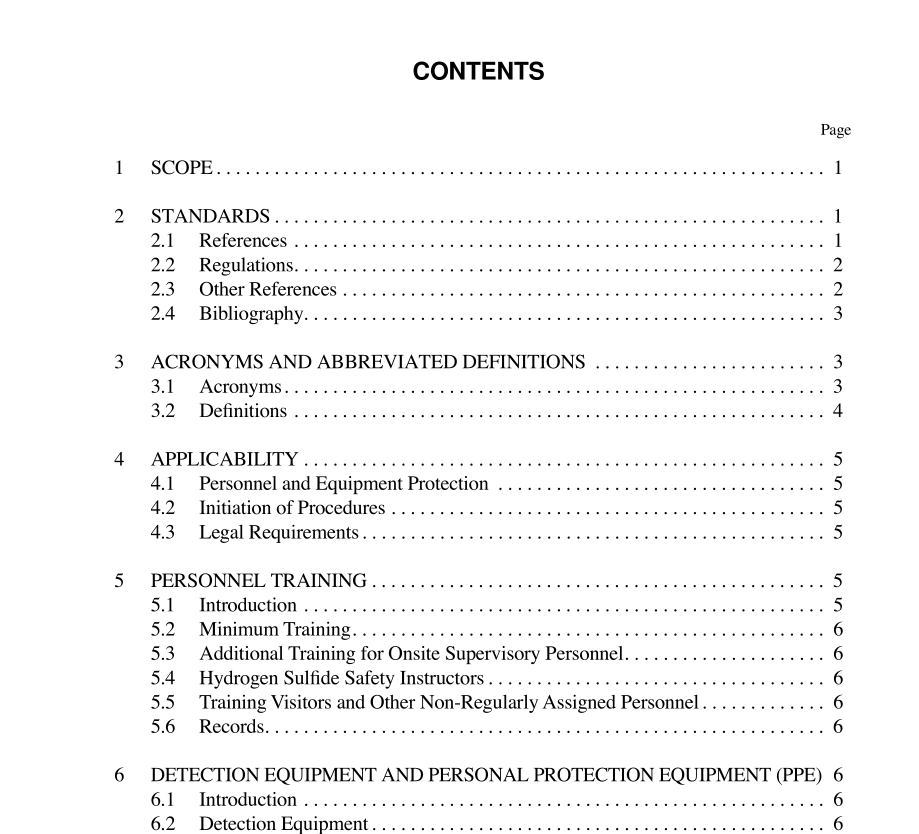API RP 49 RUSSIAN pdf download

API RP 49 RUSSIAN pdf download.Recommended Practice for Oil and Gas Well Drilling and Servicing Operations Involving Hydrogen SulÞde
1 Scope
Recommendations set forth in this publication apply to oil and gas well drilling and servicing operations involving hydrogen sulÞde. These operations include well drilling, completion, servicing, workover, downhole maintenance, and plug and abandonment procedures conducted with hydrogen sulÞde present in the ßuids being handled. Coverage of this publication is applicable to operations conÞned to the original wellbore or original total depth and applies to the selection of materials for installation or use in the well and in the well drilling or servicing operation(s). The presence of hydrogen sulÞde in these operations also presents the possibility of exposure to sulfur dioxide from the combustion of hydrogen sulÞde. Refer to Section 4 for applicability of this standard. This standard addresses personnel training, personnel pro- tective equipment, contingency planning and emergency pro- cedures, classiÞcation of locations, materials and equipment, operations, rig practices, special operations, offshore opera- tions, characteristics of hydrogen sulÞde and sulfur dioxide, and evaluation and selection of hydrogen sulÞde monitoring equipment.
3.2 DEFINITIONS
For the purposes of this standard, the following deÞnitions are applicable. 3.2.1 acceptable ceiling concentration (ACC): The designated level of an air contaminant to which an employee may be exposed at any time during an 8-hour shift, except for a time period and up to a concentration not exceeding the Òacceptable maximum peak above the acceptable ceiling con- centration for an 8-hour shiftÓ. 3.2.2 action levels: The levels at which the possibility of hydrogen sulÞde atmospheric concentrations greater than 10 ppm or sulfur dioxide atmospheric concentrations greater than 2 ppm may be encountered. 3.2.3 breathing zone: Generally, a hemisphere forward of the shoulders with a radius of 6 in. to 9 in. 3.2.4 continuous hydrogen sulfide monitoring equipment: Equipment capable of continuously measuring and displaying the concentration of hydrogen sulÞde in ambi- ent air. 3.2.5 enclosed facility: A three-dimensional space enclosed by more than 2 / 3 of the possible projected plane surface and of sufÞcient size to allow the entry of personnel. For a typical building, this would require that more than 2 / 3 of the walls, ceiling, and ßoor be present. Refer to API RP 500 and RP 505. 3.2.6 essential personnel: Those individuals required to provide proper and prudent safe operations activities and those required to effect control of the hazardous hydrogen sulÞde or sulfur dioxide conditions. 3.2.7 gas detection instrument: An assembly of elec- trical, mechanical, and chemical components designed to sense and respond continuously to the presence of chemical gases in atmospheric mixtures. 3.2.8 hydrogen sulfide: Chemical formula is H 2 S. A ßammable, toxic gas that is heavier than air and sometimes found in ßuids encountered in oil and gas producing and gas processing operations.3.2.9 immediately dangerous to life and health (IDLH): An atmospheric concentration of any toxic, corro- sive, or asphyxiant substance that poses an immediate threat to life or would cause irreversible or delayed adverse health effects or would interfere with an individualÕs ability to escape from a dangerous atmosphere. The ACGIH has estab- lished 300 ppm or greater of H 2 S as an IDLH exposure. 3.2.10 inadequately ventilated: Ventilation (natural or artiÞcial) that is not sufÞcient to prevent the accumulation of signiÞcant quantities of toxic or inert gases such that a hazard is created. 3.2.11 length-of-stain detector: A specially designed pump and colorimetric indicator tube detector (length-of- stain), with a supply of detector tubes, that operates by using the pump to pull a known volume of air or gas through a detec- tor tube. The tubes contain chemical reagents that are designed to detect the presence and display the concentration of speciÞc gases or vapors in the sample. The length of the resultant color band in the tube indicates an instantaneous quantitative con- centration of the speciÞc chemical in the sample. 3.2.12 permissible exposure limit (PEL): TWA con- centrations that must not be exceeded during any 8-hour work shift of a 40-hour work week. PELs are subject to change. 3.2.13 shall: Indicates the Òrecommended practice(s)Ó has universal applicability to that speciÞc activity. 3.2.14 shelter-in-place: The concept of providing the public protection from exposure to toxic gas or vapor releases to the environment by having residents stay indoors until emergency evacuators arrive or the emergency is over. 3.2.15 short term exposure limit (STEL): A 15- minute TWA exposure that should not be exceeded at any time during a workday.









